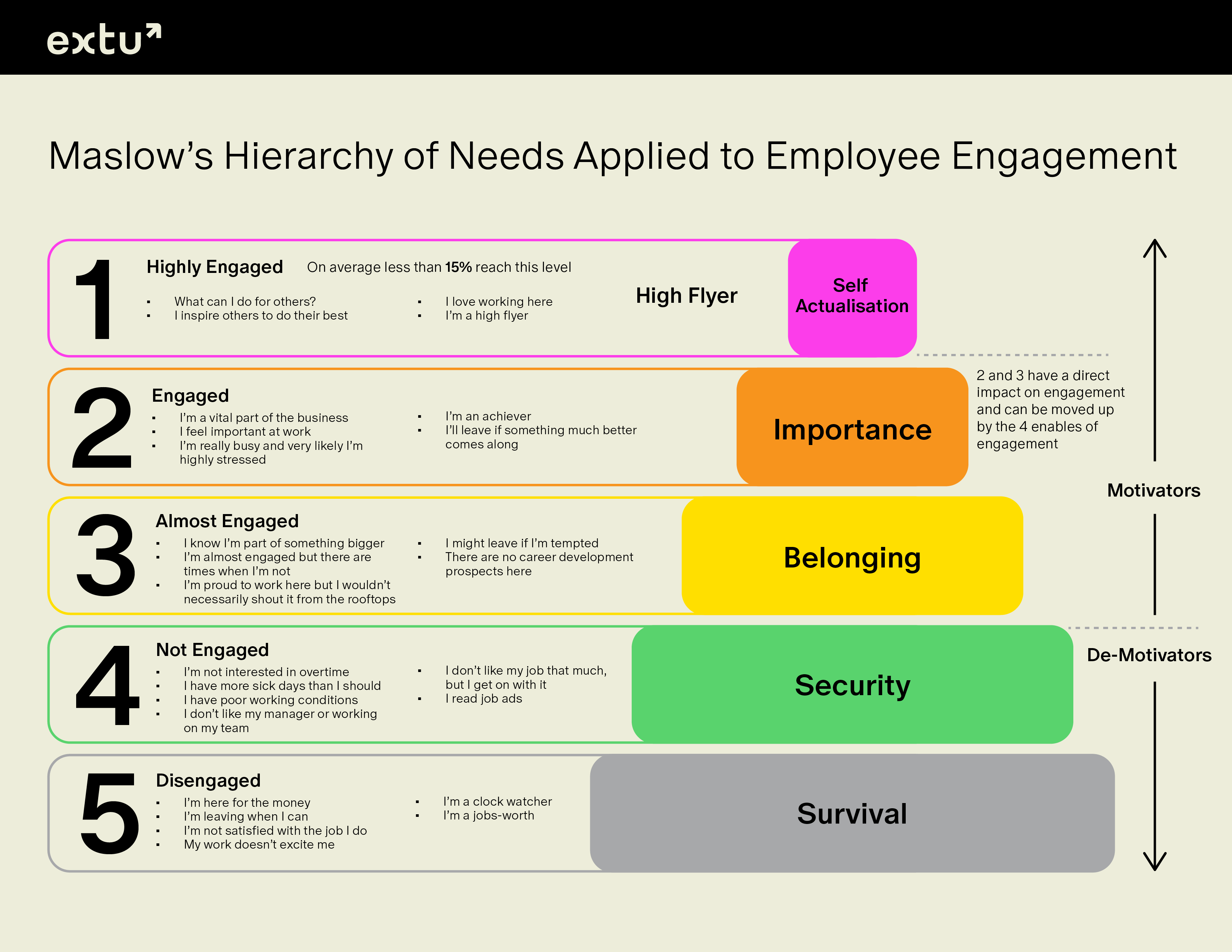If you’ve ever held a management position or you’re a psychologist, then you’re probably familiar with Abraham Maslow and his Hierarchy of Needs theory. Maslow’s theory suggests that human mental health and well-being are determined by needs being fulfilled in a specific order – all leading to what he calls “self-actualization,” which is the ability of an individual to pursue their own personal goals and development. They’re able to do this because all of their other needs are met. How do employee engagement and Maslow’s Hierarchy of Needs relate to each other? The hierarchy tells us a lot about what kind of motivation employees need.
 Let’s start by looking at Maslow’s theory in its entirety. Time for a refresher course! Maslow proposed the following as the basic needs for human survival and achievement:
Let’s start by looking at Maslow’s theory in its entirety. Time for a refresher course! Maslow proposed the following as the basic needs for human survival and achievement:
- Survival – Food, water, shelter, rest
- Safety – Security, law and order, protection from elements (also shelter)
- Belonging – Friendship, love, intimacy, affection
- Importance – Mastery of skills, independence, respect
- Self-Actualization – Fulfillment of personal growth and achievements
While these needs may have been laid out for basic human survival, they’re also applicable to employee engagement and how “motivated” they are to participate in standard and extracurricular business activities. Let’s see how Maslow’s needs factor into your employee’s psyches:
- Survival – The most basic of needs. Employees, and humans in general, need a place to live and shelter, so they need a salary that pays the bills and provides these necessities.
- Safety – Beyond just having a job, employees need to innately feel that their jobs are secure. This is more important than ever with the way the job market’s performed over the past six years.
- Belonging – This need plays out in the workplace as the need to be part of a team and a part of something they feel is “bigger than themselves.” They also need to feel that their individual contributions are valued by the company. They need to feel like they matter.
- Importance – This need overlaps with the “belonging” need a bit. People need to know that they are an integral part of whatever they’re participating in. This need is especially important in a larger corporation where it’s easy for employees to feel like they’re lost inside the machine and often looked over. When they feel this way they get demotivated and can drag the engagement of those around them down as well.
- Self-Actualization – Employees who have the training they need, the tools they require, and a well-structured environment where they feel they belong and make valuable contributions can finally start to self-actualize. They start contributing ideas, leading, and bringing others along for the ride by inspiring them to be better employees. The kind of behavior exhibited when employees reach this level on Maslow’s chart is contagious and highly beneficial to have at your company.
Now that we’ve established how important it is for your employees to have their needs met, how do you go about fulfilling them and providing an environment where employees can “self-actualize?” Let’s break it down again:
- Survival – If your employees need wages to live, then give them wages enough to live on. If you don’t pay employees enough to put a roof over their head, then don’t expect them to care too much about keeping your balance sheet in a positive place.
- Safety – Your employees don’t need to feel like their job is on the line with every single decision they make. This adds untold amounts of undue stress and can cause losses in productivity, morale, and overall profitability. If you have managers who make your employees feel this way – change their behavior, or change the manager.
- Belonging – Create and promote a strong team-oriented culture and inclusionary efforts. Recognize teams and individuals for their accomplishments and they’ll be more likely to perform better in the future.
- Importance – This is the need where employee recognition becomes important. Recognizing your employees publicly, or through an employee recognition incentive program, lets them know that they are doing well, their contributions matter, and they’re viewed as valuable by the company.
- Self-Actualization – When you provide the tools, the education, the environment, and the stability, the employees can provide this and realize their potential. When they reach this level of engagement, they inspire others around them and perform optimally – which is best for business.
If you’d like to learn more about applying Maslow’s Hierarchy of Needs to your company, call us today at 1-866-567-7432. We’ll discuss with you how you can find out where employees are at on the chart, and how you can utilize tools like sales incentive programs to boost employee engagement and performance.
Learn more about employee engagement!
10 Examples of Gamification for Employee Engagement
Gamification tools help you engage employees in fun and exciting ways. Read More!
The Psychology Behind Employee Motivation
Learn more about the brain science of motivation so you can more effectively engage and motivate your workforce. Read more!
Encouraging Employee Motivation Through Internal Promotion
Before you turn to a recruiter or headhunter, consider promoting internally. It boosts employee morale and motivation. Read more!



